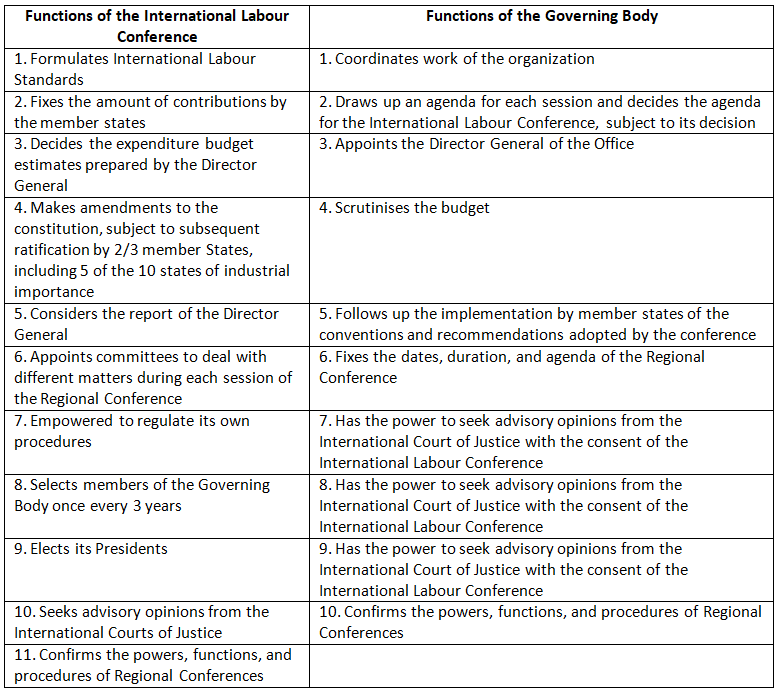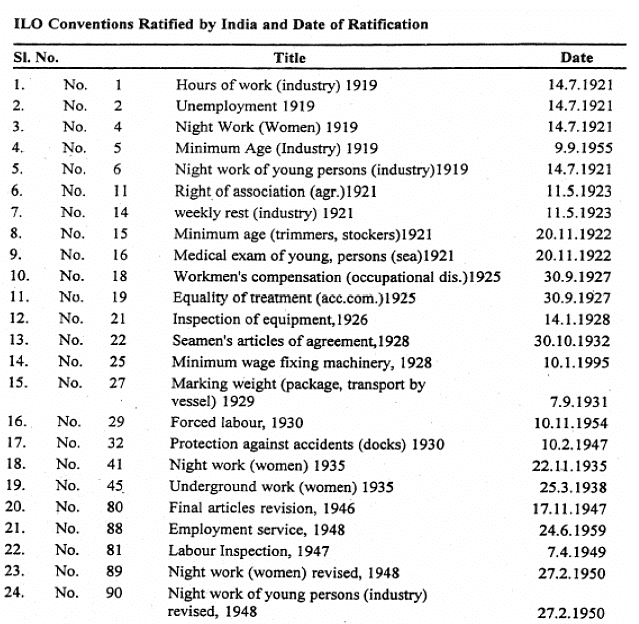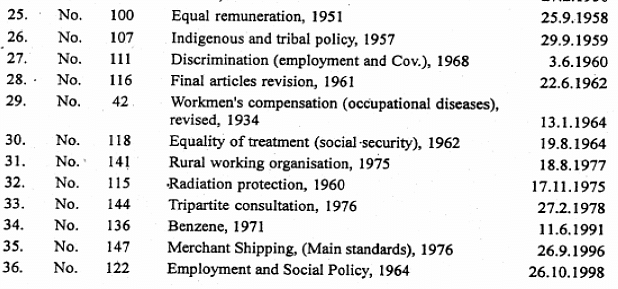ILO and its Functions | Commerce & Accountancy Optional Notes for UPSC PDF Download
| Table of contents |

|
| Introduction to ILO |

|
| Objectives of the ILO |

|
| International Labour Standards |

|
| International Labour Standards and their Influence on Indian Labour Legislations |

|
Introduction to ILO
Established in 1919 under the Treaty of Versailles, the International Labour Organization (ILO) stands as a key international organization. Since its inception, it has dedicated itself to tirelessly working towards the establishment of global peace through social justice. Recognizing its significant contributions, the ILO was honored with the Nobel Peace Prize in 1969. Its primary focus has been on developing international standards for application at the national level, supported by technical cooperation and education. In 1919, the ILO had 45 member states, with India being one of the founding members. Over time, the ILO's membership has increased to 174.
Objectives of the ILO
- The ILO's objectives, outlined in its constitution's preamble, supplemented by Article 427 of the Peace Treaty of Versailles in 1919 and the Philadelphia Declaration of 1944, are guided by a fundamental ideology. The preamble emphasizes that universal and lasting peace can only be achieved through social justice. It recognizes that unjust and harsh labor conditions affecting a large population can lead to unrest jeopardizing global peace and harmony. The failure of any nation to adopt humane labor conditions is viewed as an obstacle to other nations seeking improvement in their own conditions.
- The ILO has been dedicated to promoting worldwide respect for the freedom and dignity of working men, striving to create conditions for the fuller and more effective enjoyment of such freedom and dignity.
- During the Second World War, a conference in Philadelphia in April 1944 resulted in the redefinition of the ILO's aims, known as the Declaration of Philadelphia, later incorporated into the ILO's constitution. This conference reaffirmed key principles, including the acknowledgment that labor is not a commodity, freedom of expression and association is vital for sustained progress, poverty anywhere poses a threat to prosperity everywhere, and the battle against want requires relentless efforts nationally and through international collaboration.
- The Declaration of Philadelphia introduced ten objectives that the ILO aimed to further and promote globally, all centered around the theme of social justice. These objectives include achieving full employment, raising standards of living, providing suitable employment, ensuring just conditions of work, recognizing the right of collective bargaining, extending social security measures, protecting worker life and health, promoting child welfare and maternity protection, offering adequate nutrition, housing, and facilities for creation and culture, and ensuring equality of educational and vocational opportunity.
The Structure of the ILO
The ILO functions through three main components:
(1) An International Labour Conference
(2) A Governing Body
(3) An International Labour Office
The International Labour Conference serves as the supreme policymaking and legislative body. The Governing Body acts as the executive council, while the International Labour Office functions as the secretariat, operational headquarters, and information center.
The International Labour Conference is responsible for policymaking within the ILO and consists of three groups representing governments, employers, and workers in a ratio of 2:1:1. Sessions are held at least annually, and delegates, accompanied by advisors (not exceeding two for each agenda item), participate. Government delegates are typically ministers, diplomats, or officials following government instructions. According to the ILO's constitution, employers' and workers' delegates are nominated by governments in agreement with relevant industrial organizations.
The Governing Body
This is one of the principal bodies of the ILO. It is a non-political, non-legislative, tripartite body. It carries out the decisions of the Conference with the help of the International Labour Office. It consists of 56 members of which 28 represent governments, 14 employers and 14 workers. Of the 28 member government contingent, 10 are appointed by the members of the States of Chief Industrial Importance and the balance are delegates of other governments. The criteria laid down for the selection of members of Chief Industrial Importance is the strength of its total industrial population. India is one of the ten States of Chief Industrial Importance. The period of office of this body is 3 years. It meets several times a year to take decisions on the programmes of the ILO.
The functions of this body are given below:
The International Labour Office
- The International Labour Office (ILO) constitutes the third major component in the ILO system, serving as the Secretariat located in Geneva. The Chief Executive of this office is the Director General, appointed by the Governing Body, and also acting as the Secretary-General of the Conference. The Director General appoints the staff, including two deputy director generals, six assistant director generals, directors of specialized institutes, advisors, chiefs of divisions, and staff from various nations.
- The constitution of the ILO outlines the main functions of this office, which include:
- Preparation of documents related to the Conference agenda items.
- Assistance to governments in formulating legislation based on ILC decisions.
- Implementation of functions related to the observance of conventions.
- Publication of materials addressing international industrial labor issues.
- Collection and distribution of information on international labor and social problems.
- Regarding the finance of the ILO, the budget is determined by the ILC based on the recommendations of the Governing Body, with member states contributing according to fixed ad hoc amounts on a yearly basis.
International Labour Standards
- The International Labour Standards, representing accumulated global experience in advancing higher social and economic goals, remain the primary tool for the ILO in promoting social justice worldwide. The International Labour Conference, functioning as the legislative branch of the ILO, serves as a platform for discussing and deliberating on international labor issues, leading to the formulation of standards in the form of conventions and recommendations. Together, these conventions and recommendations are referred to as the international labor code.
- The significance of standard-setting activities stands out as the foremost priority in the overall plans and programs of the ILO. As highlighted in the In-depth Review of International Labour Standards in February 1976, this element is deemed crucial in the development of ILO action and must be coordinated with other forms of activities such as studies, research, and operational initiatives.
Conventions and Recommendations
- Conventions and Recommendations serve distinct roles, with Conventions being instruments that create obligations, while Recommendations provide guidance. When a member state ratifies a Convention, it becomes a binding international obligation, establishing specific requirements. Recommendations, on the other hand, offer guidance for national action and do not impose international obligations.
- In some cases, a Recommendation may precede a Convention and pave the way for its subsequent adoption. Additionally, a Recommendation may complement a Convention by specifying detailed methods for applying the basic rules or principles outlined in the Convention. Although Recommendations do not create binding obligations, they are not inferior standards; they cover a broad range of functions and serve a different purpose.
- As standards progress, Conventions undergo revisions, and new amendments incorporating higher labor standards are adopted.
International Labour Code
The body of Conventions and Recommendations adopted by the International Labour Conference constitutes the International Labour Code. As of now over 180 Conventions (and Recommendations) have been adopted by the Conference. The code has become for labour lawyers throughout the world what the Corpus Juris Civilis or the works of authority of the common lawyers are for other lawyers.
The international labour code covers an enormous range of important subjects in the labour and social fields, which have been classified as under:
- Basic Human Rights
- Labour Administration and Industrial Relations
- Employment Policy and Human Resources Development
- General Conditions of Employment
- Employment of Children, Young Persons and Women
- Industrial Safety, Healthy and Welfare
- Social Security and Social Policy
- Seafarers
- Indigenous and Tribal Populations Migrants and Plantation Workers
Ratification Procedures
The ILO Standards operate similarly to treaties, requiring ratification by a competent national authority within a timeframe ranging from one year to a maximum of 18 months from the conclusion of the I.L.C session.
In India, the authority for treaty-making rests with the Government of India. A Tripartite Committee is established to outline the ratification program for ILO Conventions, conducting a thorough examination. Recommendations from this committee guide India in ratifying Conventions. If the committee does not advise on the ratification of a specific instrument, it provides reasons for such a decision.
India has ratified a total of 36 conventions among those adopted by the ILO.

Information on the measures taken in pursuance of the ratified convention has to be conveyed through annual reports to be sent to International Labour office.
Some of the factors responsible for non-ratification are as follows:
- Inadequacy of coverage in India.
- Administrative inadequacies
- Legal difficulties
International Labour Standards and their Influence on Indian Labour Legislations
As per the National Commission on Labour, India is obligated to fulfill international responsibilities stemming from its longstanding association with the ILO. These obligations involve adopting the ILO's goals and objectives for national initiatives, participating in ILO programs, and progressively implementing ILO standards.
The impact of International Labour Conventions and Recommendations on Indian legislation varies. In some cases, the influence is direct, leading to the enactment of new laws, modifications to existing laws, or changes in administrative practices and procedures after ratification.
The ILO's Conventions and Recommendations have notably influenced the following areas in India:
- Factories and Mines Legislation, addressing aspects such as working hours, weekly rest, holidays with pay, and wages, including provisions for the employment of children, young persons, women working at night, and industrial health, safety, and welfare.
- Wage legislations, with the ratification of Convention 26 on minimum wages fixing machinery in 1955, prompting amendments to the Minimum Wages Act and the establishment of an advisory committee for guidance.
- Social Security, where various ILO Conventions and Recommendations covering aspects like workmen compensation, sickness insurance, invalidity, old age and survivors' insurance, unemployment provisions, maternity protection, and general social security have influenced Indian laws either directly or indirectly.
Industrial Relations
- Right from the beginning, the ILO has given attention to freedom of association, collective bargaining and constructive industrial relations. Relevant conventions are:-the Right of Association (Agriculture (Noll) 1921, The Freedom of Association and Protection of Right to Organise (No87) 1948, and Right to organise and collective bargaining (No98), 1949. The Recommendations include- Collective Agreements (No91), 1951, The Voluntary Conciliation and Arbitration (No 92), 1951, and the Cooperation at the Level of Undertaking (No94), 1952.
- The existing Indian Legislation embodying the provisions of some of the above instruments is the Trade Union Act 1926. Other principles of these conventions and recommendations can also be seen in different industrial relations legislations.
Conclusion
Thus, the ILO standards have influenced Indian Labour Legislation, directly and indirectly. In fact, the blue print of our labour policy is based on ILO's Standards. The influence of ILO can be seen in our Directive Principles of State Policy (Articles 39, 41, 42, 43, 43A which lay down policy objectives in field of labour. They have been greatly influenced by ILO's preamble and Philadelphia Declaration. The National Labour bodies - The Indian Labour Conference and Standing Labour Committee resemble the two main structures of ILO. Therefore, the influence of ILO has been perceptible in Labour Legislations in India.
|
196 videos|219 docs
|
FAQs on ILO and its Functions - Commerce & Accountancy Optional Notes for UPSC
| 1. What is the objective of the International Labour Organization (ILO)? |  |
| 2. What are International Labour Standards? |  |
| 3. How do International Labour Standards influence Indian labor legislations? |  |
| 4. What are the functions of the International Labour Organization (ILO)? |  |
| 5. How does the ILO contribute to the UPSC exam? |  |














